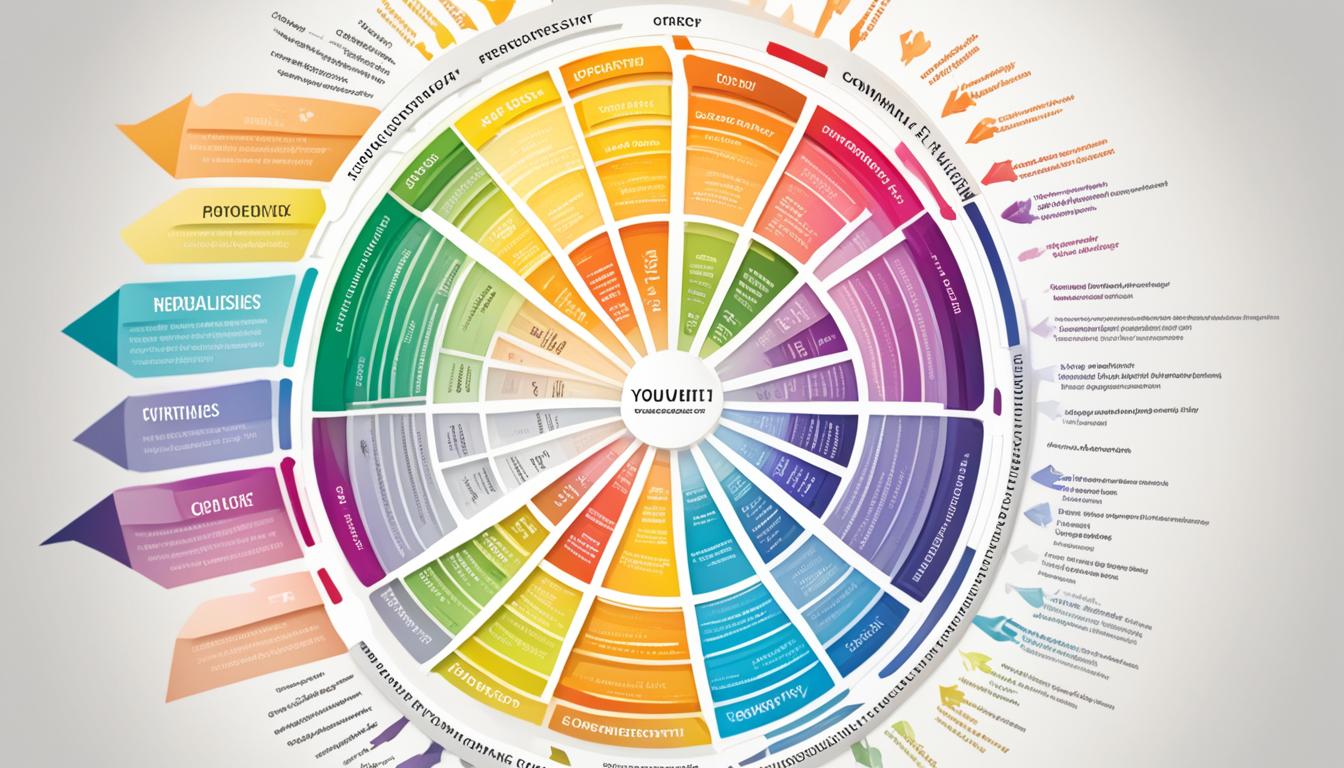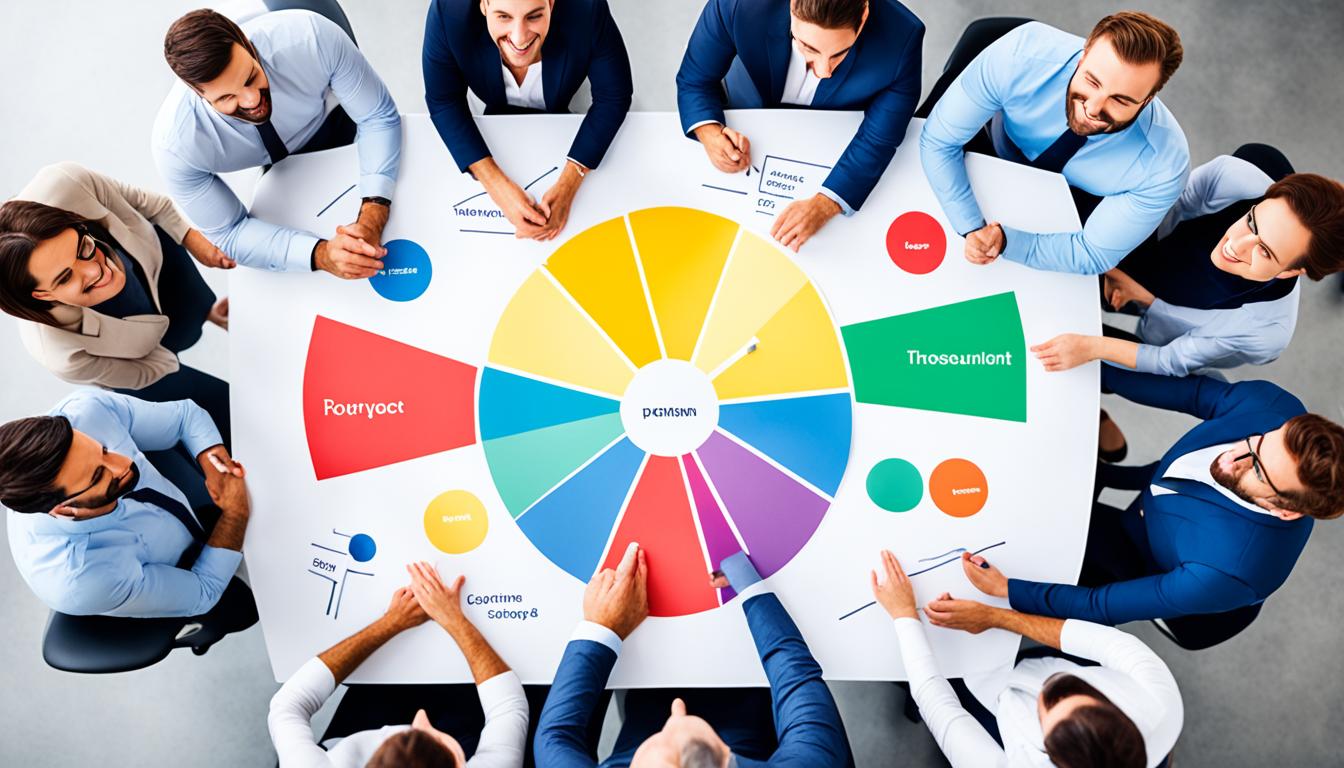Welcome to our article series dedicated to understanding the unique characteristics and behaviors of Gen Z in the modern workplace. In this first section, we will explore the benefits of taking a personality test and how it can help Gen Z individuals discover their true potential. By gaining insights into their personality traits, young professionals can better align themselves with roles that match their strengths and preferences. One particularly insightful tool is the *dark core personality test*, which delves into less-discussed aspects of character, helping individuals recognize and manage potentially harmful traits. Understanding these deeper layers of personality can lead *Gen Z* workers to develop more self-awareness and foster healthier relationships in the workplace.
As a part of Generation Z, you belong to a generation that values self-expression, individuality, and authenticity. Taking a personality test can provide you with invaluable insights into your strengths, weaknesses, and work preferences, helping you navigate the complexities of the modern workplace with confidence.
Understanding how your personality aligns with different work styles and communication preferences can significantly enhance your self-awareness, improve your relationships with colleagues, and boost your overall career satisfaction. By gaining a deeper understanding of yourself, you can unlock your full potential and thrive in the workplace.
Key Takeaways:
- Taking a personality test can provide Gen Z individuals with valuable insights into their unique characteristics and work preferences.
- Understanding your personality can enhance self-awareness and improve your relationships with colleagues.
- Gaining insights into your strengths and weaknesses can help you make more informed career decisions.
- Self-awareness is a crucial component of personal and professional growth for Gen Z individuals.
- Discovering your edge through a personality test can lead to greater career satisfaction and success.
The Impact of Generational Differences in the Workplace
Our behavior and communication styles in the workplace are heavily influenced by our generation, external habits, and early professional experiences. Experts have observed that miscommunication and misunderstandings often arise when individuals from different generations fail to understand each other’s communication styles. As workplaces become more diverse with multigenerational workforces, it becomes crucial to comprehend the characteristics of each generation to enhance cooperation and teamwork.
“The workplace is a melting pot of different generations, each with their own unique characteristics, communication preferences, and work styles. To foster effective collaboration and avoid unnecessary conflicts, it is important for individuals to acknowledge and adapt to these generational differences.”
The Importance of Generational Understanding
Generational differences bring varied perspectives, values, and work expectations into the professional environment. By gaining insight into these differences, we can build stronger relationships, improve workplace communication, and promote a more inclusive and harmonious work environment.
- Bridging the Communication Gap: Each generation has its preferred communication methods, whether it’s face-to-face meetings, emails, or instant messaging. Understanding and respecting these preferences can prevent misunderstandings and facilitate smoother collaboration.
- Adapting to Work Styles: Baby Boomers, Gen Xers, Millennials, and Gen Zers each have their own work styles and approaches to problem-solving and decision-making. By understanding and appreciating these differences, we can leverage the strengths of each generation and improve overall team performance.
- Creating a Positive Work Culture: A workplace that values and acknowledges generational differences fosters a sense of belonging and respect among employees. Encouraging open dialogue and creating opportunities for intergenerational collaboration can promote a positive work culture that embraces diversity.
By recognizing and embracing generational differences, we can transform potential challenges into opportunities for growth, learning, and innovation. Building strong relationships across generations ultimately leads to enhanced teamwork, increased productivity, and higher job satisfaction.
Understanding the Characteristics of Each Generation
To effectively navigate generational differences, it is important to familiarize ourselves with the unique characteristics and preferences of each generation in the workforce. The table below provides an overview of the four main generations and highlights some key differences:
NOTE: This table is for illustrative purposes only and does not encompass the entire range of traits and characteristics associated with each generation.
Acknowledging these generational differences can help us approach workplace communication and relationships with empathy and understanding. By adapting our communication styles, embracing diverse perspectives, and fostering collaboration, we can create a more inclusive and harmonious work environment for multigenerational workforces.
The Rise of Gen Z in the Workplace
As the Gen Z population enters the workforce, organizations are facing new communication challenges and opportunities. Generation Z, born between 1997 and 2012, is projected to make up a significant portion of the multigenerational workforce in the coming years. With their unique communication style shaped by growing up in a digital era, Gen Z employees can encounter confusion and misunderstanding when interacting with older colleagues. To foster better workplace relationships, it is crucial to understand and adapt to Gen Z’s communication preferences.
In an era marked by rapid technological advancements and digital transformation, Gen Z brings a fresh perspective to the workplace. They have grown up in a world where instant messaging, social media, and collaborative platforms are the norm. As such, their communication preferences tend to be more informal, concise, and digitally focused.
This cultural shift can pose challenges when Gen Z employees interact with coworkers from different generational backgrounds. Older generations may prefer more traditional forms of communication, such as face-to-face conversations or phone calls, while Gen Z employees lean towards digital channels like email, chat, and social media platforms.
Understanding these differences and finding common ground is essential for effective collaboration and teamwork in multigenerational work environments. By embracing Gen Z’s communication preferences and adapting to their digital-centric approach, organizations can bridge the communication gap, build stronger connections, and leverage the strengths of the multigenerational workforce.
The Importance of Open Communication
Open and transparent communication plays a pivotal role in addressing the communication challenges posed by the rise of Generation Z in the workplace. It is crucial to encourage a culture where employees feel comfortable sharing their thoughts, ideas, and concerns. Emphasizing the value of open dialogue allows for the exchange of diverse perspectives and ensures that everyone’s voice is heard.
“When different generations communicate openly and respectfully, it leads to increased understanding and collaboration, ultimately fueling innovation and success.”
Adapting Communication Styles
Adapting communication styles to meet the needs of a multigenerational workforce is necessary for effective collaboration. To accommodate Gen Z’s communication preferences, consider implementing the following strategies:
- Utilize digital channels for quick updates and informal conversations.
- Provide clear guidelines and expectations regarding communication channels for different situations.
- Encourage face-to-face or phone conversations when complex or sensitive topics require in-depth discussion.
By finding the right balance between digital communication and more traditional methods, organizations can create an environment that fosters effective communication, regardless of generational differences.
Embracing Technology
Embracing technology is key in bridging the communication gap between Gen Z and other generations. Organizations can leverage digital tools and platforms to facilitate communication, collaboration, and knowledge sharing. By providing training and support for these tools, companies can empower employees of all generations to embrace technological advancements and leverage them for improved productivity and efficiency.
Ultimately, understanding and adapting to the communication preferences of Generation Z is essential in creating a harmonious and productive workplace environment. By embracing their digital mindset and fostering open communication, organizations can tap into the full potential of the multigenerational workforce and thrive in an increasingly digital world.

Understanding Gen Z’s Communication Style
Gen Z, also known as “zoomers,” has been immersed in the digital world from a young age, shaping their unique communication style. Growing up with social media and digital devices, Gen Z has developed a preference for concise and visually-oriented communication.
This generation heavily relies on emojis to express emotions and convey meaning in their messages. Unlike previous generations, Gen Z uses emojis for connotation rather than denotation. These small digital icons allow them to add layers of sentiment to their messages, making their communication more nuanced and expressive.
Gen Z’s communication style is also marked by their use of humor, often with a cynical edge. This can result in different interpretations of emojis among older colleagues who may not be familiar with the changing meanings and cultural references associated with these symbols.
To effectively communicate with Gen Z colleagues, it’s essential to understand their communication preferences and adapt accordingly. This includes being familiar with popular emojis, recognizing their connotative meanings, and understanding the implications of Gen Z’s humor.
Furthermore, Gen Z’s communication style extends beyond emojis. They often use unconventional punctuation marks and expressions to convey tone and emphasis. For example, Gen Z commonly omits periods at the end of sentences in informal digital communication, considering them unnecessary or even negative. By being aware of these communication nuances, you can establish better rapport and avoid misinterpretations with Gen Z counterparts.
Key Characteristics of Gen Z’s Communication Style:
- Extensive use of emojis for connotation
- Cynical humor with an edge
- Unconventional punctuation and expressions
| Generation | Communication Style | Emphasis |
|---|---|---|
| Gen Z | Emojis, concise messaging, visual communication | Connotation, layering of sentiment |
| Previous Generations | Traditional text-based communication | Denotation, literal interpretation |
To illustrate Gen Z’s communication style, consider the following example:
Gen Z: Hey, I’m so excited for the concert tonight! 😃🎉
Older Colleague: Have fun at the concert! Don’t forget to bring your earplugs. 😉
In this interaction, the Gen Z individual uses emojis to convey their genuine excitement about the concert, while the older colleague uses a winking emoji to indicate a playful suggestion. Gen Z’s use of emojis adds layers of expression and visual cues to their messages.
Understanding Gen Z’s communication style, characterized by their digital nativity, emoji usage, and unique expression, is crucial for effective communication and collaboration in today’s multigenerational work environments.
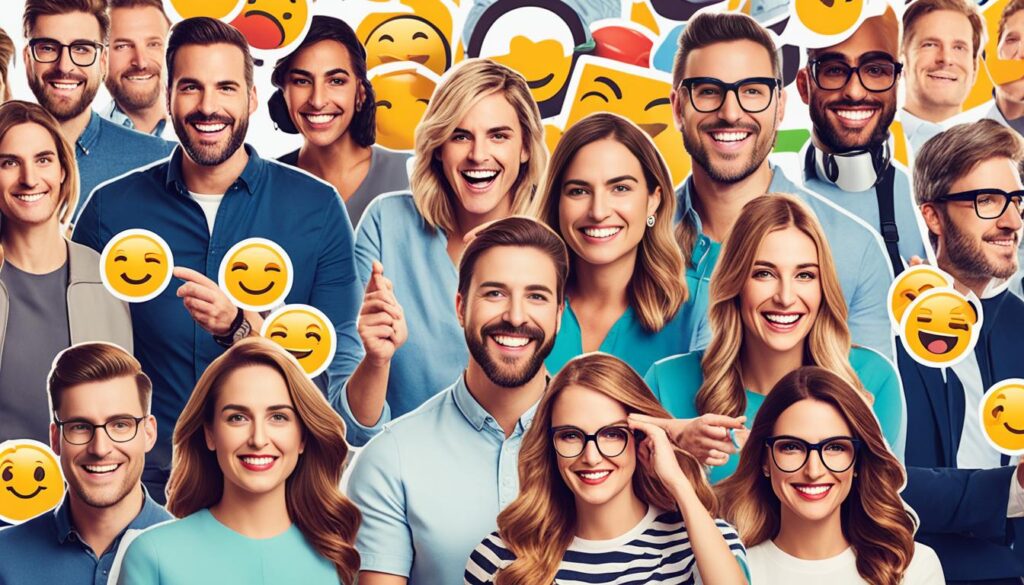
The Role of Emojis and Punctuation Marks
Gen Z’s communication style sets them apart from previous generations, particularly when it comes to emojis and punctuation marks. Understanding these nuances is crucial for effective communication and bridging the generation gap in the workplace.
One key aspect of Gen Z’s communication style is their tendency to omit periods in their messages. Unlike older generations, Gen Z considers periods unnecessary and may perceive them as conveying negative emotions or being overly formal. By recognizing and adapting to this preference, we can avoid misunderstandings and ensure smoother communication with Gen Z colleagues.
Emojis also play a significant role in Gen Z’s communication. However, it’s important to note that emojis carry nuanced meanings and can vary in intensity. Different smiley faces can represent varying levels of enthusiasm or convey subtle emotions. Understanding these interpretations is essential for accurate comprehension and avoiding miscommunication.
“By redesigning punctuation, we express not just emphasis but actual signs of emotion. We’ve taken the idea of punctuation and made it part of the performance.” – David Crystal
Embracing Gen Z’s communication preferences fosters better workplace relationships and collaboration. By incorporating their preferred use of emojis and punctuation, we can create a more inclusive environment where everyone feels understood and valued.
Benefits of Understanding Emoji Interpretations
- Enhances cross-generational communication
- Reduces misunderstandings and misinterpretations
- Fosters a positive and inclusive work environment
- Allows for clearer expression of thoughts and emotions
By adapting our communication strategies to accommodate Gen Z’s preferences, we can build stronger connections and improve overall workplace dynamics. Let’s explore the significance of language evolution and word usage in the next section.
Language Evolution and Word Usage
Language is a living entity that evolves over time, influenced by changing cultural and societal norms. Among the younger generation, such as Gen Z, this evolutionary process is particularly evident in the development of new meanings for words and phrases. With the rise of social media platforms, word usage and language trends can spread quickly among peers, creating a unique lexicon that becomes emblematic of their generation.
However, it’s crucial to recognize that meanings can also shift rapidly, making it essential to stay updated on current expressions to avoid misunderstandings. Popular culture, including music, movies, and social media influencers, often plays a significant role in shaping language trends and introducing new vocabulary into mainstream usage.
In the digital age, where communication is increasingly dominated by text messages, social media posts, and online interactions, the influence of pop culture on language evolution is even more pronounced. Memes, viral phrases, and references from popular TV shows or movies can quickly become part of everyday communication, creating a shared language that fosters a sense of belonging and cultural identity.
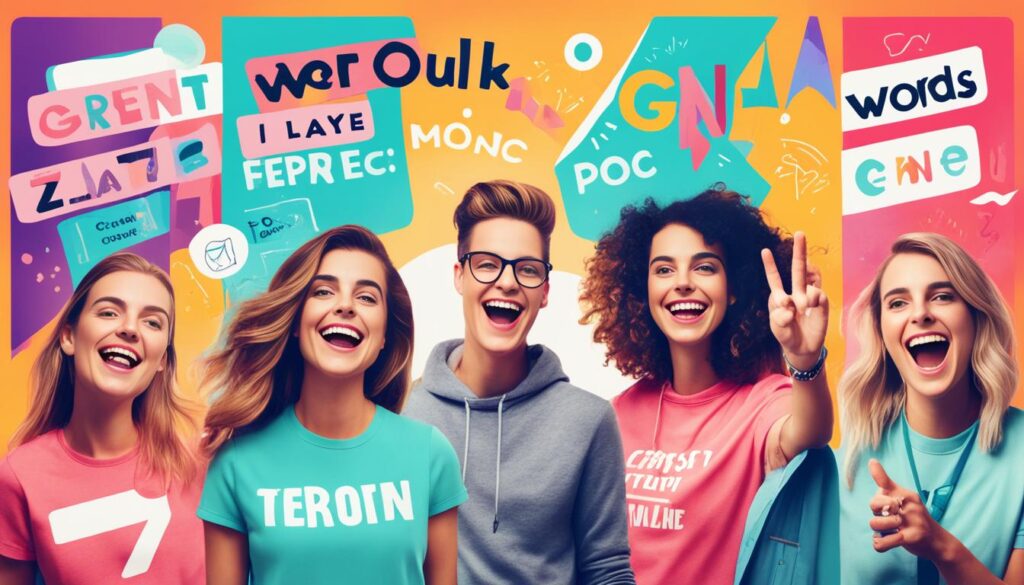
By recognizing and embracing these linguistic changes, we can improve communication and bridge the gap between generations. It allows us to adapt our language to better connect with younger individuals and understand their unique perspectives. Additionally, staying attuned to the evolving meanings and nuances of words and phrases enables us to express ourselves effectively and avoid misinterpretations.
“Language is not a fixed entity but a fluid, constantly evolving manifestation of human expression. Embracing this evolution fosters cultural understanding and enables effective communication across generational boundaries.”
Harness the power of language evolution to enhance your communication skills and foster meaningful connections with individuals of all ages. Embrace the influence of pop culture, stay informed about the latest language trends, and use this knowledge to navigate the ever-changing landscape of modern communication.
Nonverbal Communication in the Digital Age
In today’s digital era, a significant portion of our communication takes place online. With the absence of physical presence, understanding nonverbal cues becomes crucial. Nonverbal communication, which includes gestures, facial expressions, and body language, plays a vital role in conveying emotions and intentions. However, in the absence of these traditional cues, Gen Z has developed their own set of nonverbal cues in the virtual world.
One of the most prominent examples is the use of emojis. Emojis, those little colorful icons, have become a universal language of expression in online communication. They serve as digital cues that help convey sentiment, tone, and meaning. Each emoji carries its interpretation, allowing individuals to express various emotions without relying solely on words.
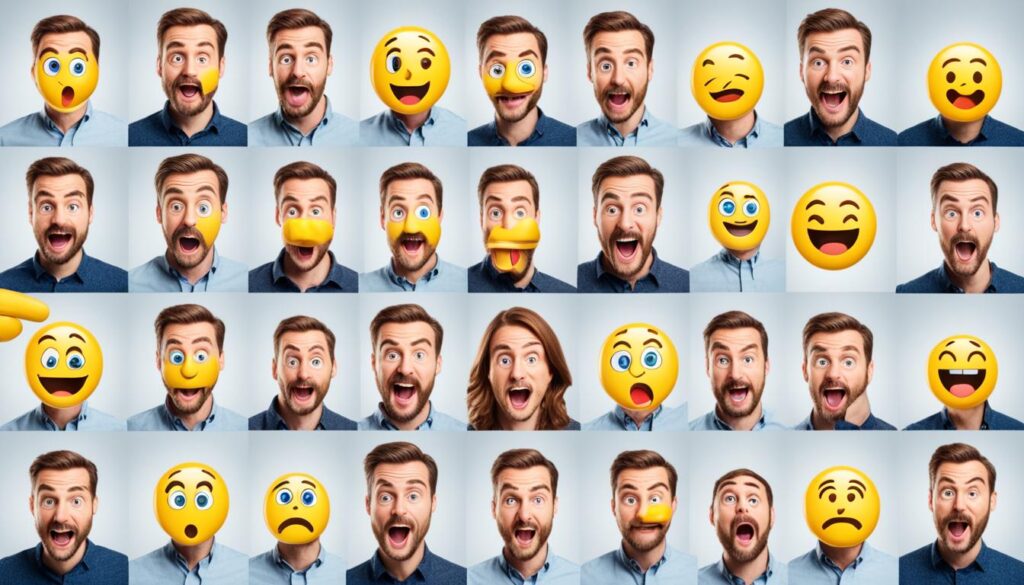
Different emojis can convey varying levels of enthusiasm, excitement, or nonchalance. For example, a simple smiley face can indicate happiness, while a face with tears of joy can represent intense laughter. By using specific emojis, people can express their feelings and intent more precisely, creating a richer and more nuanced digital communication experience.
“Emojis are like the body language of the digital age. They add context and emotional nuances to our messages, helping us create better connections with others.”
The Importance of Emoji Interpretations
Understanding the interpretations and meanings behind emojis is crucial for effective communication, especially when bridging the generational gap. Gen Z, being digital natives, have a deeper understanding of these digital cues and their intended messages. However, for older colleagues and individuals from different generations, emoji interpretations may not always be clear. Different cultures, backgrounds, and personal experiences can also influence how emojis are perceived.
Recognizing these nonverbal cues and having open conversations about their interpretations can help mitigate potential miscommunications in the workplace. It fosters cross-generational understanding and paves the way for smoother communication and collaboration.
The Evolution of Nonverbal Communication
The rise of nonverbal communication in the digital age is a testament to the constant evolution of human interaction. As technology continues to shape the way we communicate, it is crucial for individuals of all generations to adapt and understand these digital cues. By recognizing and embracing the unique nonverbal communication styles of Gen Z and other generations, we can bridge the gap and create a more inclusive and effective communication environment.
The Importance of Personality Type in Career Satisfaction
Career satisfaction is a fundamental aspect of overall happiness and fulfillment in life. However, many individuals find themselves reaching a point where they no longer enjoy their jobs or feel unsatisfied with their career paths. This realization often stems from a lack of alignment between their personality type and their chosen profession.
Understanding one’s personality type can be a powerful tool in identifying an ideal career path that aligns with individual strengths, preferences, and values. It provides valuable insights into our natural inclinations, work style, and interpersonal dynamics, enabling us to make more informed decisions about our careers.
One widely used tool for exploring personality type is the Myers-Briggs Type Indicator (MBTI). The MBTI assesses individuals based on four key dimensions: extraversion/introversion, sensing/intuition, thinking/feeling, and judging/perceiving. By categorizing individuals into one of sixteen distinct personality types, the MBTI offers increased self-awareness, a deeper understanding of strengths and weaknesses, and insights into potential career paths that can lead to greater job satisfaction.
When we leverage our personality type in career decisions, we are more likely to find fulfillment and success in our chosen fields. By aligning our innate preferences and aptitudes with the demands and requirements of specific jobs or industries, we increase the likelihood of thriving in our professional endeavors.
Understanding our personality type allows us to make career choices that align with our unique strengths and inclinations, leading to greater job satisfaction and a sense of purpose.
Moreover, when individuals are aware of their personality type, they can actively seek out work environments and cultures that complement their preferences. For example, an introverted individual who thrives in quiet and reflective settings may find more satisfaction in a career that provides opportunities for focused work or independent projects, rather than a role that requires constant interaction and collaboration.
The Impact of Personality Type on Job Performance
Research has shown that individuals who have a good match between their personality type and their job roles are more likely to perform well and experience higher levels of job satisfaction. When our work aligns with our personality, we are more motivated, engaged, and fulfilled, resulting in enhanced productivity and overall career success.
Additionally, understanding our personality type can improve our interpersonal relationships in the workplace. By recognizing and appreciating the diverse personality types of our colleagues, we can foster better communication, collaboration, and teamwork, ultimately leading to a more positive and harmonious work environment.
| Personality Type | Characteristics | Preferred Career |
|---|---|---|
| ENFJ | Empathetic, charismatic, and persuasive | Human resources, counseling, or teaching |
| INTP | Analytical, logical, and independent | Research, engineering, or computer programming |
| ESFJ | Warm, supportive, and diligent | Healthcare, hospitality, or event planning |
| ISTJ | Reliable, organized, and detail-oriented | Accounting, project management, or law enforcement |
Remember, each personality type is unique, and there is no one-size-fits-all approach to career satisfaction. The key is to understand your own preferences, strengths, and values, and to seek out career paths that align with who you are at your core.
By leveraging the insights provided by personality type assessments like the MBTI, we can embark on a career journey that not only brings professional success but also personal fulfillment and happiness.

Using MBTI for Career Guidance
The MBTI assessment is a valuable tool that provides insights into an individual’s natural preferences for learning, problem-solving, and energy management. By understanding these preferences, we can make informed decisions when it comes to career selection, aligning our strengths with the roles and industries that best suit us.
The MBTI assessment also plays a crucial role in navigating interpersonal relationships in the workplace. By appreciating the differences among personality types, we can foster a harmonious and collaborative work environment. Understanding our coworkers’ preferences can help us communicate effectively, resolve conflicts, and mitigate misunderstandings.
Working with a certified MBTI practitioner can further enhance the interpretation and application of assessment results. These practitioners have in-depth knowledge and expertise in the MBTI framework, offering personalized guidance to help individuals make sound career decisions based on their unique personality traits.
Let’s take a look at an example of how the MBTI assessment can assist in career guidance:
Example: MBTI Career Preferences
| MBTI Type | Career Preferences |
|---|---|
| ISTJ (Introverted, Sensing, Thinking, Judging) | Accountant, Engineer, Project Manager |
| ENFJ (Extraverted, Intuitive, Feeling, Judging) | Teacher, Counselor, Sales Manager |
| INFP (Introverted, Intuitive, Feeling, Perceiving) | Writer, Social Worker, Graphic Designer |
| ESTP (Extraverted, Sensing, Thinking, Perceiving) | Entrepreneur, Pilot, Marketing Manager |
As shown in the example, individuals with different MBTI types tend to gravitate towards specific careers. These preferences are based on the characteristic traits associated with each personality type. By identifying our MBTI type, we can gain insights into our natural inclinations and make informed decisions when it comes to career selection.
Whether we’re just starting our career journey or looking for a change, the MBTI assessment can provide valuable guidance by aligning our personal preferences with the world of work. It empowers us to choose career paths that not only capitalize on our strengths but also promote long-term satisfaction and fulfillment.
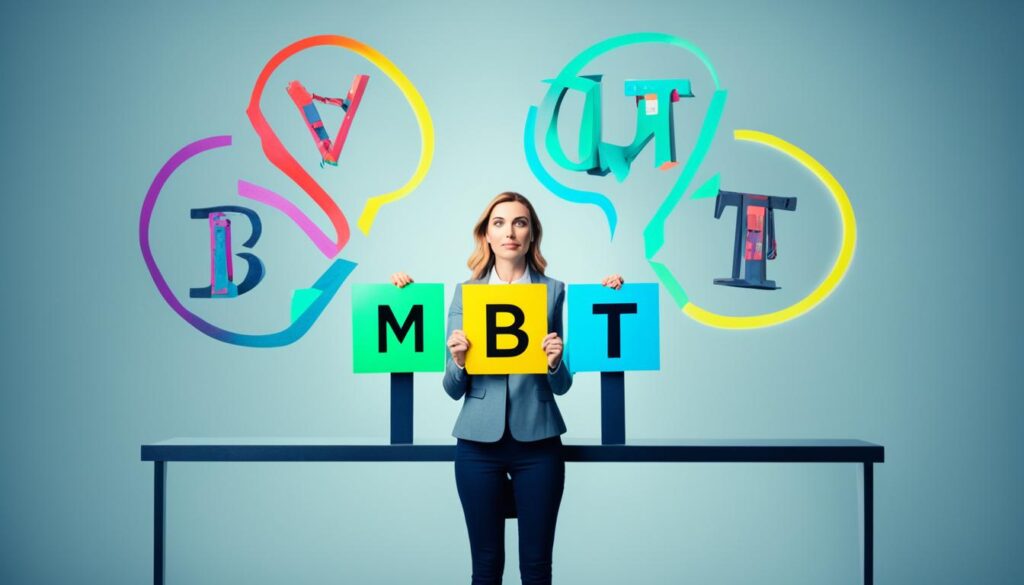
The Power of Self-Awareness in Career Success
Self-awareness is a critical component of personal and professional growth. Understanding ourselves and our natural preferences allows us to make informed decisions that align with our career goals.
One powerful tool for developing self-awareness is the Myers-Briggs Type Indicator (MBTI) assessment. By taking the MBTI, individuals gain a deeper understanding of their personality traits and potential areas for growth. This knowledge can be invaluable in shaping our career paths and finding greater satisfaction in our work.
When we align our career goals with our personal preferences, we set ourselves up for success. By pursuing work that resonates with our natural strengths and interests, we are more likely to experience fulfillment and engagement in our careers.
Moreover, self-awareness enables us to navigate the complexities of work culture. By recognizing the diverse perspectives and personalities of our colleagues, we can foster a positive and inclusive work environment where everyone feels valued and heard.
Developing self-awareness is an ongoing process. It requires reflection, introspection, and a willingness to embrace personal growth. The MBTI assessment serves as a valuable tool on this journey, providing insights that guide our decisions and interactions.

Embrace the power of self-awareness in your career success. By understanding yourself and appreciating the unique qualities of others, you can navigate the workplace with confidence, purpose, and authenticity.
The Benefits of Self-Awareness in Career Success
- Improved decision-making: Self-awareness helps us align our choices with our values and aspirations.
- Enhanced communication: Understanding our communication styles and those of others fosters effective collaboration and teamwork.
- Better work-life balance: By recognizing our needs and preferences, we can create a work-life balance that promotes well-being and fulfillment.
- Increased resilience: Self-aware individuals are better equipped to handle challenges and setbacks, adapting and growing in the face of adversity.
“Self-awareness is the foundation on which we build our careers and shape our futures.”
Conclusion
Discovering your unique personality traits and understanding how they influence your communication style and work preferences can be a powerful tool for personal and professional growth. By taking a personality test, such as the MBTI, you can gain valuable insights that will help you navigate the complexities of the modern workplace, bridge generational gaps, and find greater career satisfaction.
Embrace self-discovery and utilize these insights to unlock your full potential and build a fulfilling career journey. By understanding your natural preferences and strengths, you can make more informed decisions, align your career goals with your personal values, and find greater satisfaction in your work.
Remember, self-awareness is the key to personal and professional success. Invest in your own growth and development by exploring your unique personality traits. By doing so, you’ll gain a deeper understanding of yourself, improve your interpersonal relationships, and create a positive impact in the workplace. Your journey towards self-discovery starts now – embrace it and thrive!
FAQ
How can taking a personality test benefit Gen Z individuals?
Why is understanding generational differences important in the workplace?
What are the communication challenges posed by Gen Z in the workplace?
How does Gen Z’s communication style differ from previous generations?
How does language evolution and word usage impact workplace communication?
What is the role of nonverbal cues, such as emojis, in workplace communication?
Why is personality type important in career satisfaction?
How does the MBTI assessment assist in career guidance?
How does self-awareness contribute to career success?
How can a personality test like the MBTI help in personal and professional growth?
Source Links
- https://edgecareersolutions.com/mbti-for-career-success/
- https://www.washingtonpost.com/technology/interactive/2023/gen-z-boomers-office-lingo-slang/
- https://www.washingtonpost.com/technology/interactive/2022/gen-z-work-slang-quiz/
Eugene brings a fresh, dynamic voice to our platform as one of our talented Writers. Specializing in research-driven content, he explores the latest findings in psychology and personal growth, translating them into actionable insights for our readers. Eugene’s work is fueled by a curiosity about what makes us tick and a desire to help others unlock their potential.



